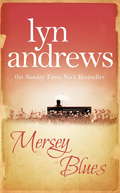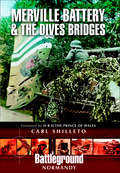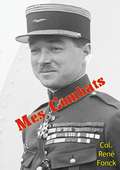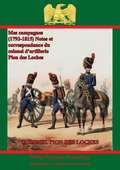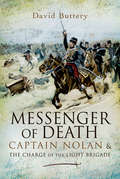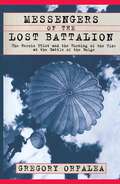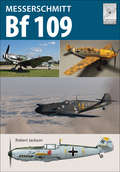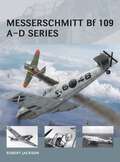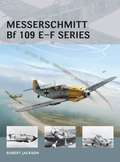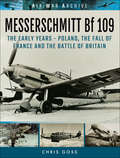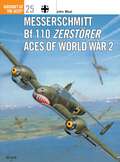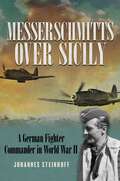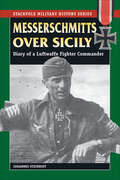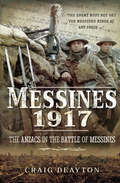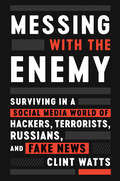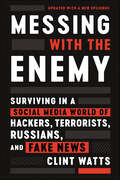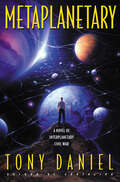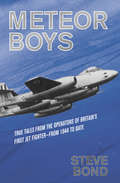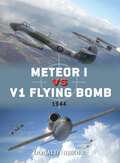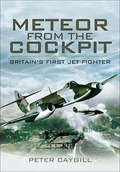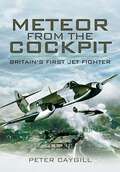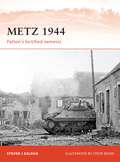- Table View
- List View
Mersey Blues: An engaging and nostalgic saga of life after the war
by Lyn AndrewsFor three friends, life after the Great War will never be the same again... Mersey Blues is a heart-rending portrayal of Liverpool in the years between the wars - of the rebuilding of the city, and the people's dreams of peace, from bestselling author Lyn Andrews. Perfect for fans of Anne Baker, Dilly Court and Sheila Newberry. Mersey Blues is the sequel to Lyn Andrews' much-loved wartime saga, Mist Over The Mersey.The Great War had ended and Scotland Road was left to count the cost. Many young men had not come back; those who had would never be the same again. Dee Chatterton and Abbie Kerrigan had seen the horrors of war for themselves as nurses in military hospitals abroad. While Abbie settled down in the familiar surroundings of Scotland Road, for others, different horizons beckoned. Dee went to live in Canada, while their friend Hannah Harvey became personal nurse to none other than Richard, seventh Earl of Ashenden, badly injured in the war. Moving to the splendours of Ashenden Hall was to bring her unimagined happiness, but also the heartache of being separated for ever from her family and friends. What readers are saying about Mersey Blues: 'Very good read, just could not wait to read it. Brilliant writer''I enjoyed the story so much I immediately bought another Lyn Andrews. Somehow I just flew through the pages, which I think shows that the pace keeps you turning the pages''Five stars'
Merville Battery & the Dives Bridges (Battleground Normandy)
by Carl ShilletoThis battlefield guide is the companion work to Pegasus Bridge & Horsa Bridge. Together, these two books form the fully revised and updated edition of the previous best selling Battleground Europe Series book Pegasus Bridge & Merville Battery.This book examines, in great detail, the attack by 9 Para Bn of the British 6th Airborne Division on the German gun emplacement known as the Merville Battery on D-Day, 6 June 1944. The actions of 8 Para, 12 Para, Canadian 1 Para, attached engineer and support units, and commando raids in this area of Normandy are also told. In particular, the importance of destroying the five bridges, and a drainage culvert, in the Dives valley are explained along with the importance of taking and holding the high ground to the north-east of Caen. These combined actions resulted in the protection and securing of the left flank of the greatest combined military operation in history; Operation OVERLORD.In addition to explaining how these objectives were achieved, this battlefield guide relates the battles to the area as it is today. The book contains details of the museums, memorials, cemeteries and associated organizations. All of which will unravel the history of the area to the visitor and armchair traveler alike.To further aid the battlefield tourist, GPS data is also provided for either satellite navigation by vehicle or for viewing on Google Earth.
Mes Combats
by Col. René Fonck Maréchal Ferdinand Foch« Le simple récit de ses combats, véritables exploits épiques accomplis dans les airs, donne un exemple des activités, des énergies, des vertus, mises en jeux dans les luttes nationales de nos jours. Par là cet ouvrage indique aux générations à venir la hauteur morale où elles doivent monter leur préparation à la guerre, ce qui est, dans la paix, leur devoir. » Préface du Maréchal Foch.
Mes campagnes (1792-1815) - Notes et correspondance du colonel d'artillerie Pion des Loches (1792-1815) - Notes et correspondance du colonel d'artillerie Pion des Loches: mises en ordre et publiées par Maurice Chipon et Léonce Pingaud.
by Colonel Antoine-Augustin Pion des Loches« PION DES LOCHES (Antoine-Augustin), 1770-1819.Mes campagnes (1792-1815). Notes et correspondance du colonel d'artillerie Pion des Loches, mises en ordre et publiées par Maurice Chipon et Léonce Pingaud. Paris, Firmin-Didot, 1889, in-16, XXVIII-520 p., portr., index.Vingt-neuf cahiers de notes et une correspondance avec une épouse forment la trame de ces souvenirs de Pion des Loches. Attachants mémoires, surtout sur la campagne de Russie (ch. V) qui présentent un type d'officier écartelé entre l'attrait de la gloire militaire et les plaisirs de la vie conjugale. Bonne édition critique. » p 135 - Professeur Jean Tulard, Bibliographie Critique Des Mémoires Sur Le Consulat Et L'Empire, Droz, Genève, 1971
Messenger of Death: Captain Nolan & The Charge of the Light Brigade
by David ButteryA biography of the British Army officer and his role in the Crimean War at the Charge at Balaklava.Captain Louis Nolan delivered the order that produced one of the most famous blunders in all military history—the Charge of the Light Brigade. Nolan’s conduct and the Charge itself have been the subject of intense, sometimes bitter debate ever since. Yet there has been no recent biography of Nolan. He remains an ambiguous, controversial figure to this day. In this fresh and perceptive study, David Buttery attempts to set the record straight. He reassesses the man and looks at his military career, for there was much more to Louis Nolan than his fatal role in the Charge. This sympathetic account of his life throws new light on the Victorian army and its officer class, and on the conduct of the war in the Crimea. It also offers the reader an inside view of the most notorious episode of that war, the Charge at Balaklava on 25 October 1854.
Messengers of the Lost Battalion: The Heroic 551st and the Turning of the Tide at th
by Gregory OrfaleaThe author of Before the Flames and the son of a member of the ill-fated infantry battalion discusses America's 551st Battalion and their heroic, little-known role during World War II's Battle of the Bulge.
Messerschmitt Bf 109 (Flightcraft Ser. #14)
by Robert JacksonThe famous Messerschmitt Bf 109 single-seat fighter was one of the most important warplanes of the Second World War. Originally designed during the 1930s, and a contemporary of the equally-legendary Supermarine Spitfire, it was vitally important to Germanys Luftwaffe and was flown in combat by the highest-scoring fighter pilots in history.It was in service throughout the Second World War and was built in a number of significant versions that proved to be worthy adversaries of the very best of the Allied warplanes that it flew against. Bf 109s operated in all the major areas of conflict where German forces were engaged in combat and, in modified form, the type even had a post-war career in several countries that extended well into the 1950s.
Messerschmitt Bf 109 A-D Series
by Robert JacksonBefore it won glory in the Battle of France, and experienced defeat in the Battle of Britain, the Messerschmitt 109 tasted battle in its initial A/B/C and D variants. This is the story of those early models of the iconic fighter, that would go on to be one of the most produced aircraft of WW2. Featuring stunning aerial photos, the book explores in depth the technical characteristics and combat performance of the early Bf 109s, including their combat debut in the Spanish Civil War and their employment in the invasion of Poland.
Messerschmitt Bf 109 E-F series
by Robert Jackson Adam ToobyThe Messerschmitt Bf 109 was one of the truly world-class piston-engined fighters of World War II. This reputation rests largely with the E-F variants, which bore the brunt of the Luftwaffe's most important operations in World War II and shot down tens of thousands of Allied aircraft in the Battle of Britain, the Blitzkriegs across Europe and on the Eastern Front. This volume looks at the design and development history of these formidable warplanes, with a meticulous technical focus and clear, detailed illustrations to reveal why the types were so effective. It explores the long process of tweaks to the E variant, and solutions to the many initial technical problems with the F, and how this development helped Willy Messerschmitt's promising Bf 109 design mature and fulfil its potential.
Messerschmitt Bf 109: The Early Years–Poland, the Fall of France and the Battle of Britain (Air War Archive)
by Chris GossThe most iconic German aircraft of the Second World War, the Messerschmitt Bf 109 was the Luftwaffes principal fighter from 1939 until 1942 when the superior Focke-Wulf Fw 190 came into greater prominence. The Bf 109 served in every theater of the war, particularly in the invasion of France and the Low Countries, the Battle of Britain and the invasion of the Soviet Union, the Mediterranean and with Rommel in North Africa. In the later years of the war, the Bf 109 fought with success in the defense of Germany against the Allied bombers. The Bf 109 was the most produced fighter aircraft in history and more aerial kills were made with this fighter than any other aircraft. In this selection of unrivaled images collected over many years, and now part of Frontline's new War in the Air series, the operations of this famous aircraft in the early part of the Second World War are portrayed and brought to life.
Messerschmitt Bf 110 Zerstörer Aces of World War 2
by John WealThis volume is the first of its type to be devoted exclusively to the Zerstörer day fighter aces, spanning the war years from Poland to the defence of the Reich. Although Messerschmitt's single-engined Bf 109 has received most of the plaudits for achieving virtual air superiority over Europe in 1939-40, the exploits of the manufacturer's twin-engined Bf 110, the Ju 88 and the Me 410 Zerstörer in the first year of the war also make for very impressive reading. Indeed, on the eve of World War 2 a posting to a Bf 110 unit was considered to be the best career move available in the Luftwaffe.
Messerschmitts Over Sicily: A German Fighter Commander in World War II
by Johannes SteinhoffIn an account of unusual power, Luftwaffe ace Johannes Steinhoff recounts the final days of the German air force on Sicily in June and July 1943. Facing crushing odds—including a commander, Hermann Göring, who contemptuously treated his pilots as cowards—Steinhoff and his fellow Messerschmitt 109 pilots took to the skies day after day to meet waves of dreaded Flying Fortresses and swarms of Allied fighters, all bent on driving the Germans from the island. A captivating narrative and a piercing analysis based on the author&’s personal World War diary, this book is a classic of aerial combat. A concluding chapter assesses the war's lessons for air forces.
Messerschmitts Over Sicily: Diary of a Luftwaffe Fighter Commander (Stackpole Military History Series)
by Johannes SteinhoffA German air force officer&’s first person account of aerial battle during the invasion of Sicily in WWII. In an account of unusual power, Luftwaffe ace Johannes Steinhoff draws from his personal World War II diary to recount the final days of the German air force on Sicily in June and July 1943. Facing crushing odds—including a commander, Hermann Goring, who contemptuously treated his pilots as cowards—Steinhoff and his fellow Messerschmitt 109 pilots took to the skies day after day to meet waves of dreaded Flying Fortresses and swarms of Allied fighters, all bent on driving the Germans from the island. A captivating narrative and a piercing analysis, this book is a classic of aerial combat.
Messines 1917: The ANZACS in the Battle of Messines (Australian Army Campaigns Ser. #18)
by Craig DeaytonThe enemy must not get the Messines Ridge at any price So read the orders to German troops defending the vital high ground south of Ypres. On 7 June 1917, the British Second Army launched its attack with an opening like no other. In the largest secret operation of the First World War, British and Commonwealth mining companies placed over a million pounds of explosive beneath the German front-line positions in 19 giant mines which erupted like a volcano. This was just the beginning. By the end of that brilliant summers day, one of the strongest positions on the Western Front had fallen in the greatest British victory in three long years of war. For the Anzacs, who comprised one third of the triumphant Second Army, it was their most significant achievement to that point; for the men of the New Zealand Division, it would be their finest hour.It is difficult to overstate the importance of Messines for the Australians, whose first two years of war had represented an almost unending catalogue of disaster. This was both the first real victory for the AIF and the first test in senior command for Major General John Monash, who commanded the newly formed 3rd Division. Messines was a baptism of fire for the 3rd Division which came into the line alongside the battle-scarred 4th Australian Division, badly mauled at Bullecourt just six weeks earlier. The fighting at Messines would descend into unimaginable savagery, a lethal and sometimes hand-to-hand affair of bayonets, clubs, bombs and incessant machine-gun fire, described by one Australian as 72 hours of Hell. After their string of bloody defeats over 1915 and 1916, Messines would prove the ultimate test for the Australians
Messines Ridge: Ypres (Battleground Europe Ser.)
by Peter OldhamThe battle for the possession of the villages of Messines Ridge, Messines, Wytchaete, St. Eloi, took place in 1914-17, and the final battle for Messines in 1918. The 1917 Battle of Messines was preceded by 19 giant mine explosions and was the biggest military mining effort in history. This book gives comprehensive details of what happened where and when, together with what can be seen today, including maps of all the remnants and sites.
Messing with the Enemy: Surviving in a Social Media World of Hackers, Terrorists, Russians, and Fake News
by Clint WattsA former FBI Special Agent and leading cyber-security expert offers a devastating and essential look at the misinformation campaigns, fake news, and electronic espionage operations that have become the cutting edge of modern warfare—and how we can protect ourselves and our country against them.Clint Watts electrified the nation when he testified in front of the House Intelligence Committee regarding Russian interference in the 2016 election. In Messing with the Enemy, the cyber and homeland security expert introduces us to a frightening world in which terrorists and cyber criminals don’t hack your computer, they hack your mind. Watts reveals how these malefactors use your information and that of your friends and family to work for them through social media, which they use to map your social networks, scour your world affiliations, and master your fears and preferences.Thanks to the schemes engineered by social media manipulators using you and your information, business executives have coughed up millions in fraudulent wire transfers, seemingly good kids have joined the Islamic State, and staunch anti-communist Reagan Republicans have cheered the Russian government’s hacking of a Democratic presidential candidate’s e-mails. Watts knows how they do it because he’s mirrored their methods to understand their intentions, combat their actions, and coopt their efforts.Watts examines a particular social media platform—from Twitter to internet Forums to Facebook to LinkedIn—and a specific bad actor—from al Qaeda to the Islamic State to the Russian and Syrian governments—to illuminate exactly how social media tracking is used for nefarious purposes. He explains how he’s learned, through his successes and his failures, to engage with hackers, terrorists, and even the Russians—and how these interactions have generated methods of fighting back. Shocking, funny, and eye-opening, Messing with the Enemy is a deeply urgent guide for living safe and smart in a super-connected world.
Messing with the Enemy: Surviving in a Social Media World of Hackers, Terrorists, Russians, and Fake News
by Clint WattsA former FBI Special Agent and leading cyber-security expert offers a devastating and essential look at the misinformation campaigns, fake news, and electronic espionage operations that have become the cutting edge of modern warfare—and how we can protect ourselves and our country against them.Clint Watts electrified the nation when he testified in front of the House Intelligence Committee regarding Russian interference in the 2016 election. In Messing with the Enemy, the cyber and homeland security expert introduces us to a frightening world in which terrorists and cyber criminals don’t hack your computer, they hack your mind. Watts reveals how these malefactors use your information and that of your friends and family to work for them through social media, which they use to map your social networks, scour your world affiliations, and master your fears and preferences.Thanks to the schemes engineered by social media manipulators using you and your information, business executives have coughed up millions in fraudulent wire transfers, seemingly good kids have joined the Islamic State, and staunch anti-communist Reagan Republicans have cheered the Russian government’s hacking of a Democratic presidential candidate’s e-mails. Watts knows how they do it because he’s mirrored their methods to understand their intentions, combat their actions, and coopt their efforts.Watts examines a particular social media platform—from Twitter to internet Forums to Facebook to LinkedIn—and a specific bad actor—from al Qaeda to the Islamic State to the Russian and Syrian governments—to illuminate exactly how social media tracking is used for nefarious purposes. He explains how he’s learned, through his successes and his failures, to engage with hackers, terrorists, and even the Russians—and how these interactions have generated methods of fighting back. Shocking, funny, and eye-opening, Messing with the Enemy is a deeply urgent guide for living safe and smart in a super-connected world.
Metaplanetary: A Novel of Interplanetary Civil War
by Tony DanielFree download! Peruse "The Metaplanetary Gazetteer," created by the author especially for this PerfectBound e-book.Once or twice in a score of years, the boundlessly inventive realm of speculative fiction reveals a vision of tomorrow that dwarfs everything that came before. These are the dreams of the Asimovs and the Heinleins, the Bears and the Brins. Now Tony Daniel brilliantly dreams the future -- and reinvents humanity itself -- in an epic chronicle of civil war and transcendence that plays out on an enormous stage encompassing the solar system in its entirety -- its asteroids, its comets, and all its people, transmuted into astounding forms and living astonishing lives.MetaplanetaryThe human race has extended itself into the far reaches of our solar system -- and, in doing so, has developed into something remarkable and diverse and perhaps transcendent. The inner system of the Met -- with its worlds connected by a vast living network of cables -- is supported by the repression and enslavement of humanity's progeny, nanotechnological artificial intelligences -- beings whom the tyrant Amés has declared non-human. There is tolerance and sanctuary in the outer system beyond the Jovian frontier. Yet few of the oppressed ever make it post the dictator's well-patrolled boundaries.But the longing for freedom cannot be denied, whatever the risk.A priest of the mystical religion called the Greentree Way senses catastrophe approaching. A vision foretells that the future of our bitterly divided solar system rests in the hands of a mysterious man of destiny and doom who has vanished into the backwater of the Met in search of his lost love. But the priest is not the only one who grasps this man's importance. The despot Am$eacute;s is after the some quarry -- and until now there has been no power in the inner solar system willing to oppose Amés and his fearsome minions.But now a line has been drawn of Neptune's moon Triton. Roger Sherman, a retired military commander from Earth's West Point and a Greentree ally, will not let Amés prevail. Though dwarfed by the strength and wealth of the Met, the cosmos under Sherman's jurisdiction will remain free at all cost -- though defiance will ensure the unspeakable onslaught of the dictator Amés's wrath -- a rage that will soon ravage the solar system. A rage that will plunge all of humankind into the fury of total war.With Metaplanetary, author Tony Daniel fulfills the great promise of his critically acclaimed earlier works. A new master has reached for the stars, with a stunning speculative masterwork of enormous scope and conceptual daring -- an adventure of grand victories and horrific villainy, both human and meta-human alike.
Metasurface-driven Electronic Warfare
by Rafael Goncalves Licursi de MelloUnderstand the metasurface revolution in electronic warfare Electronic warfare (EW) ensures safe usage of the electromagnetic spectrum by one’s own forces while denying it to adversaries. Modern warfare is an extraordinarily fluid and dynamic activity, with numerous involved systems reconfigurable at the front or back ends. Metasurfaces, however, are artificially engineered surfaces that promise to take this dynamism to unprecedented levels by making platforms (aircraft, vessels, etc.) and the environment itself reconfigurable – a revolution that even major EW authorities have yet to fully comprehend. Metasurface-driven Electronic Warfare outlines the parameters of this revolution and its transformative potential in the EW space. Beginning with a historical overview of EW dynamism, it then provides the electromagnetic basics to understand metasurfaces, their operation mechanisms, and capacity for shaping electromagnetic waves. A series of detailed studies of metasurface applications in EW makes this an indispensable guide to an increasingly dynamic battlefield. Readers will also find: Clear cost-benefit analyses of metasurface substitutions in modern EW scenarios Detailed discussion of metasurface applications including stealth, electronic support, electronic attack, electronic protection, their use in drone swarms, smart environments, and more Simulations of EW scenarios with accompanying MATLAB codes and exercises Metasurface-driven Electronic Warfare is ideal for EW analysts, specialists, and operators, as well as signals intelligence and electrical engineering researchers and students. Because it covers the essentials in both areas, the book is also appropriate to support graduate courses on metasurfaces or EW.
Meteor Boys: True Tales from the Operators of Britain's First Jet Fighter–From 1944 To Date
by Steve BondThrough the first-hand experiences of pilots and ground crew, the author of Javelin Boys chronicles the history of the RAF’s first jet-engined aircraft. As Britain’s first jet fighter, the Gloster Meteor has had a remarkably varied and lengthy life. But while many books have focused on its development and service history, the time has come to hear the personal experiences of its air and ground crews. By interviewing over thirty veterans, author and Meteor veteran Steve Bond has written an incredibly detailed insight into this iconic aircraft, which is supported by anecdotes and accounts from those who knew it best. One example is Alan McDonald who described the Meteor as “a bit unforgiving if you got it wrong, as many pilots found out to their cost, especially on one engine, but I must admit I got to like it very much—it was a great adrenaline rush.” Alongside these entertaining anecdotes are details of the Meteor’s origins and developments. Starting with the first deliveries in 1944 working through to the present day, Bond documents the diverse role that the Meteor has had—from operations against the V1 and photo-reconnaissance missions to its use as a training machine and later as a display aircraft. The book also features photographs never seen before in print. This detailed history of this iconic and much loved jet fighter will appeal to all aviation fans. “Bond has done a great job with this book with many personal accounts of the people that were involved every day in the life of the Meteor. Highly Recommended.” —International Plastic Modelers’ Society/USA
Meteor I vs V1 Flying Bomb
by Jim Laurier Donald NijoboerBritish jet fighters initiated jet vs. jet warfare when they fought Hitler's Nazi German V-1 attacks on London in World War II.The V1 attack on London began on the night of 13/14 June 1944 from bases in Normandy. On 29 March 1945 the last one to fall on Britain was shot down by gunners in Suffolk. A total of 10,500 missiles were launched, of which 3957 were destroyed by the defences - 3531 reached England, 2420 falling in the London area. No fewer than 6184 people were killed and 17,981 seriously injured. Indeed, it could have been much worse, for by the end of the war the Germans had manufactured close to 32,000 flying bombs. The defences put forward to guard against the V1 were formidable - 23,000 men and women with their guns, radar and communications networks were installed on coastal sites. Squadrons of Britain's newest Spitfires, the F XIVs, and Hawker Tempest Vs were kept at home to battle the new menace. While the Spitfire F XIV and Tempest V had excellent low-level speed and were able to catch the V1, there was one aircraft that was much faster. Rushed into action on 22 July 1944 to help counter the V1 threat, Britain's Gloster Meteor I was the first jet fighter to enter RAF service. At low and medium altitudes the Meteor was faster than its piston-engined contemporaries, which in turn made it perfectly suited to 'anti-Diver' V1 operations. On 4 August the Meteor scored its first V1 victory. Having just closed in on a flying bomb, Flg Off Dean of No 616 Sqn squeezed the trigger but his guns jammed. Using the Meteor's superior speed, he was able overtake the missile and, using his wing tip, he tipped the craft over and sent it crashing into the ground. This was the first time a jet-powered enemy aircraft had been destroyed by a jet fighter without a shot being fired! It was also the world's first jet versus jet encounter. As the only jet fighter squadron in Allied service in Europe, No 616 Sqn would go on to shoot down 13 V1s. A small number perhaps, but the interceptions between the V1 and Britain's Gloster Meteor were historic, and ushered in a new era of aerial combat.From the Trade Paperback edition.
Meteor from the Cockpit: Britain's First Jet Fighter
by Peter CaygillAn in-depth look at this historic military aircraft, including firsthand accounts from those who flew it. The Meteor is remembered as the first British jet fighter to enter squadron service and the only jet-powered Allied fighter to see action in WW II. Subsequent development was limited as a result of its relatively conventional airframe—although it did hold the world air speed record for a while. The Meteor was immensely strong and many pilots owe their lives to its rugged construction. For a whole generation of pilots, the aircraft—the Meatbox, as it was affectionately known—provided the ideal introduction to jet-powered flight. It did suffer a high accident rate, but many of the losses were due to lack of knowledge of the stresses of high-speed flight at low level and a misguided training program. Long after its first flight the Meteor lives on, as it is still used by Martin Baker to test ejection seats, testimony to the basic soundness of the design. This book looks into the aircraft&’s design history and development through many different variants—and includes many firsthand accounts of flying the aircraft in peace and war.
Meteor from the Cockpit: Britain's First Jet Fighter
by Peter CaygillAn in-depth look at this historic military aircraft, including firsthand accounts from those who flew it. The Meteor is remembered as the first British jet fighter to enter squadron service and the only jet-powered Allied fighter to see action in WW II. Subsequent development was limited as a result of its relatively conventional airframe—although it did hold the world air speed record for a while. The Meteor was immensely strong and many pilots owe their lives to its rugged construction. For a whole generation of pilots, the aircraft—the Meatbox, as it was affectionately known—provided the ideal introduction to jet-powered flight. It did suffer a high accident rate, but many of the losses were due to lack of knowledge of the stresses of high-speed flight at low level and a misguided training program. Long after its first flight the Meteor lives on, as it is still used by Martin Baker to test ejection seats, testimony to the basic soundness of the design. This book looks into the aircraft&’s design history and development through many different variants—and includes many firsthand accounts of flying the aircraft in peace and war.
Metternich and the Duchess
by Dorothy Gies McguiganThe life of the leader most responsible for the defeat of Napoleon's endeavors.
Metz 1944
by Steven Zaloga Steve NoonGeneral George Patton's most controversial campaign was the series of battles in autumn 1944 along the German frontier which centered on the fortified city of Metz. It took nearly four months, from September to December 1944, for Patton's Third Army to capture the Metz-Thionville fortified zone. In part, the problem was logistics. As was the case with the rest of the Allied forces in the European Theatre, supplies were limited until the port of Antwerp could finally be cleared. Also problematic was the weather. The autumn of 1944 was one of the wettest on record, and hardly conducive to the type of mechanized warfare for which Patton was so famous. However at the heart of the problem was the accretion of sophisticated fortifications. Metz had been fortified since ancient times, heavily rebuilt by France in the post-Napoleonic period, modernized by Germany in 1870-1914, and modernized by France during the Maginot effort in 1935-40. The Germans hoped to hold Metz with a thin screen of second-rate troops, counting on the impregnable fortifications. This book covers the entire campaign from beginning to end, offering an unbiased assessment of the success and failures of both the Allied and Axis efforts.
